地形和层结变化对内潮生成影响的数值模拟研究
刘 昆, 徐振华 尹宝树
(1. 中国科学院海洋研究所, 山东 青岛 266071; 2. 中国科学院海洋环流与波动重点实验室, 山东 青岛266071; 3. 中国科学院大学, 北京 100049)
地形和层结变化对内潮生成影响的数值模拟研究
刘 昆1,2,3, 徐振华1,2, 尹宝树1,2
(1. 中国科学院海洋研究所, 山东 青岛 266071; 2. 中国科学院海洋环流与波动重点实验室, 山东 青岛266071; 3. 中国科学院大学, 北京 100049)
基于ROMS(Regional Ocean Modeling System)模式, 设计了9组理想数值实验, 研究了内潮的产生对地形和背景层结环境的敏感性。结果表明: 高斯海脊两侧地形梯度较大的超临界坡面处是内潮的主要源区; 地形和层结环境的变化对内潮生成有很大影响; 如地形和层结保持不变, 不同的网格水平分辨率和垂向层数条件下估算的内潮转换率存在差别; 地形和跃层的相对空间关系对内潮生成及其引起的水体混合强度存在影响。高分辨率的地形和合适的背景层结是内潮模拟的关键。该结论对于内潮形成的数值模拟研究有一定参考价值。
内潮; ROMS(Regional Ocean Modeling System); 地形; 层结
内潮是层结的水体中正压潮流流经粗糙底地形时产生的一种内重力波。能量从正压潮转换到斜压潮中, 并从源区向远处辐射。传统上认为正压潮能量的耗散主要发生在底摩擦主导的浅水区, 而最近的研究表明约有三分之一的正压潮能量在底地形粗糙的深海区(内潮源区)耗散[1]。内潮对潜艇的航行、声波的传播、泥沙和营养盐输运等都有重要影响, 内潮同时也是深海混合能量的主要来源之一, 而这部分能量对维持热盐环流和气候调节是不可或缺的。因此, 内潮的研究对于构建深海能量收支系统和发展全球气候态环流模型参数化混合方案至关重要。
内潮生成的主要机制是正压潮流和地形的相互作用[2], 当内潮传播至较浅的陆架或陆坡处, 内潮波因非线性不稳定作用而变陡, 内潮能量向更小尺度的过程传递。通过实地观测手段研究正压潮和斜压潮的能量机制非常困难[3], 卫星遥感手段可以获得较大空间尺度的观测资料, 但是卫星高度计只能探测海表面的信号, 往往低估内潮的能量强度[4]。为了深入了解内潮的结构特征和更好地估算内潮的能量系统, 数值模拟手段被广泛应用于内潮研究中[5-10]。
蔡树群等[11]研究了底地形变化对内潮生成的影响, 指出底形效应是促使内潮产生的重要因子。除地形外背景层结环境也是内潮产生的基础条件, 对内潮的产生有重要影响[12]。内潮的数值模拟中经常要选择水平均一的温盐背景场[5-8], 不同层结环境下跃层的强度、深度和厚度均不相同。本文的工作是利用ROMS(Regional Ocean Modeling System)模式通过9组理想数值实验来研究内潮产生对地形和背景层结环境的敏感性, 为实际地形和层结环境下内潮的三维数值模拟工作提供参考。
1 研究方法
1.1 模型介绍
ROMS模式是由Rutgers University与UCLA (University of California, Los Angeles)共同开发的,在静力和Boussinesq近似下, 基于自由表面的三维非线性原始方程组的海洋数值模型[13]。为了提高计算效率, 模型采用了内外模分离的计算方法。底层流模拟的准确性对内潮的生成尤为重要, ROMS在垂向上采用σ坐标系可以较好的解决这个问题。相对于水深来说内潮的波长要大得多, 内潮引起的水质点的加速度主要在水平方向上, 因此大部分的内潮模型都是静力近似的[14]。只有在水平运动的尺度小于水深时(例如内孤立波), 非静力压强项才变的不可忽视[15]。
本文参照组实验R0选取一个二维的模拟区域(x-z), 水平长度为1 200 km, 分辨率为2 km, 垂向上取不均匀的50层, 在温跃层附近进行加密。地形采用理想的高斯地形。水平方向上采用基于深度z的温盐混合和基于σ层的动量混合, 水平黏度和扩散系数采用Smagorinsky公式[16]。垂向采用MY2.5湍闭合方案[17]。底摩擦系数取为0.003, 不考虑科氏力的影响。初始采用在水平方向上均一但垂向上层结的温盐场(图1), 初始时刻模拟区域内的动量和海表面高度都为零。东西两个边界均为开边界, 其中在东边界采用主动的Flather边界条件[18]驱动整个区域, 西边界采用被动的Flather边界条件使正压潮可以顺利流出。东边界上正压潮流振幅取为2 cm/s, 频率取M2潮频率1.41×10-4rad/s。在开边界处设置了10个网格点宽度的海绵层, 防止内潮从边界反射回计算区域。计算内模和外模的步长分别为600 s和20 s。模型计算了10 d, 每1 h输出一次结果, 并用最后2 d的模拟结果进行分析。
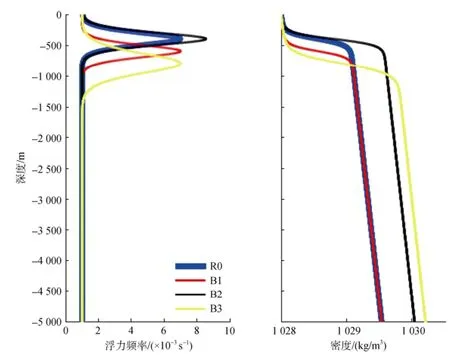
图1 实验R0和B1~B3对应的垂向层结环境和密度分布Fig. 1 Different thermocline structures and density profiles in R0 and B1-B3 cases
1.2 实验方案设计
不同的层结环境对于内潮的生成也至关重要,表征跃层特征的主要有3个量: 跃层上界深度、跃层强度和跃层厚度[19]。图2 给出了吕宋海峡附近4个季节区域平均(120°~135°E, 17°~23°N, WOA05)的垂向层结情况。因此, 本文设计了深跃层B1、强跃层B2和厚跃层B3三个实验(表1, 图1)。
Niwa等[20]指出, 不同的网格分辨率和垂向层数对内潮能量的估计也存在影响。在地形和层结环境不变的情况下, 本文设计高水平分辨率C1、多垂向分层C2和低水平分辨率C3三个实验(表1), 来探讨不同水平分辨率和垂向层数对参数化海洋模型估算内潮能量的影响。
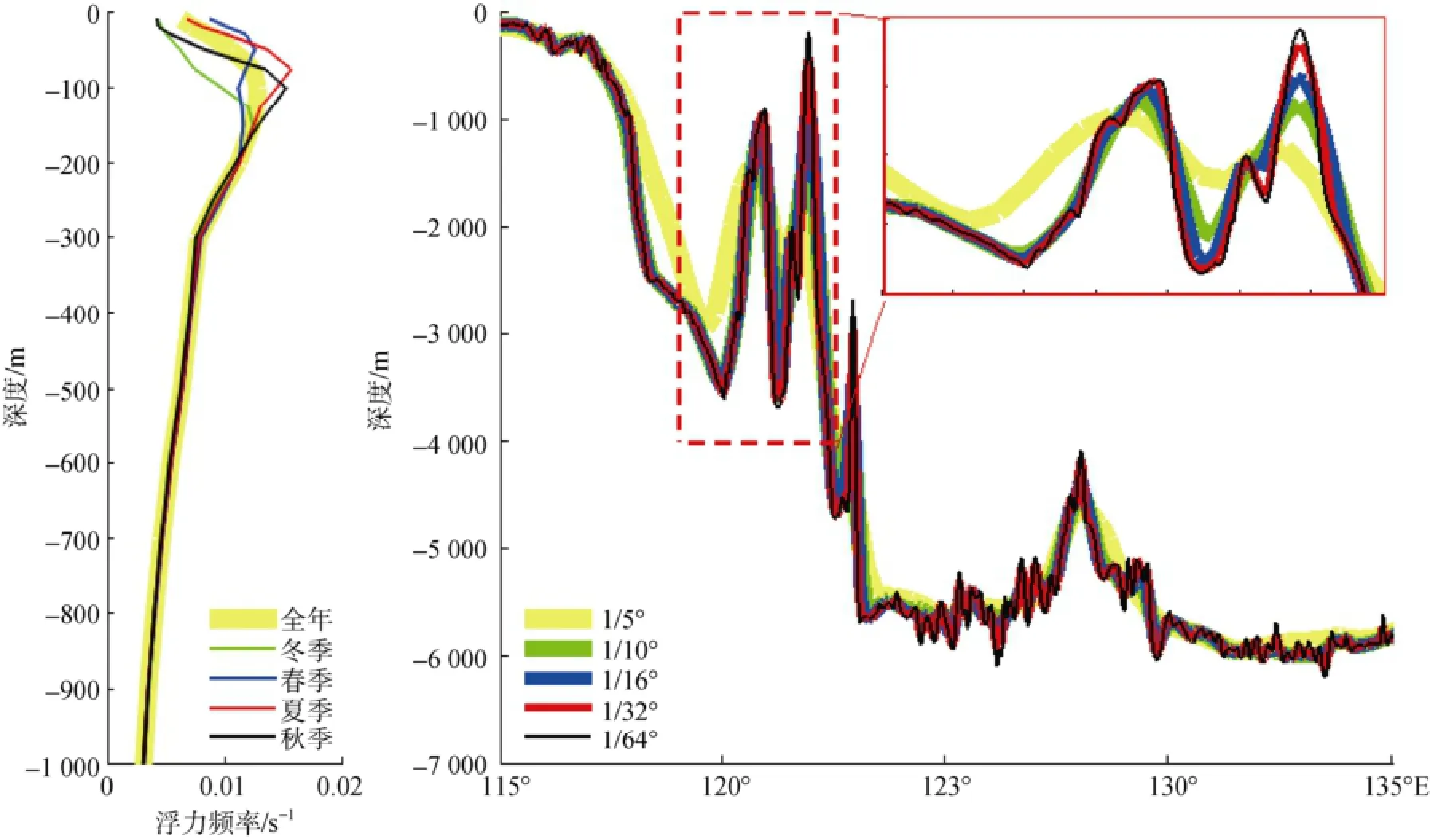
图2 吕宋海峡附近4个季节区域平均的垂向层结情况及不同分辨率下21°N断面的地形Fig. 2 Variation of the area-integrated thermocline structures of different seasons around the Luzon Strait, and the topography of section 21° N at different horizontal resolutions
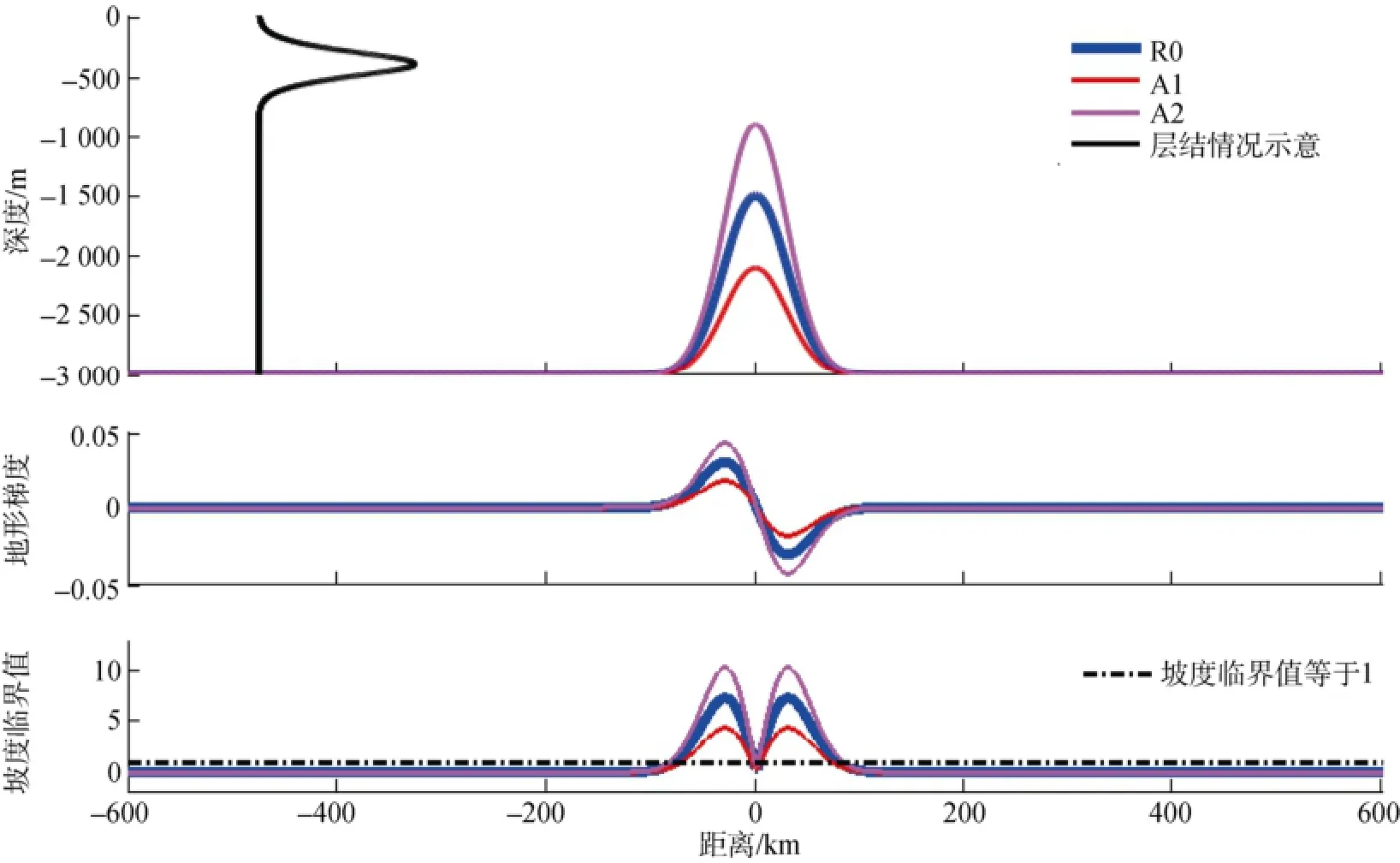
图3 实验R0, A1和A2对应的地形、地形梯度和临界情况Fig. 3 Depths, topographic gradients, and slope criticalities in R0, A1, and A2 cases
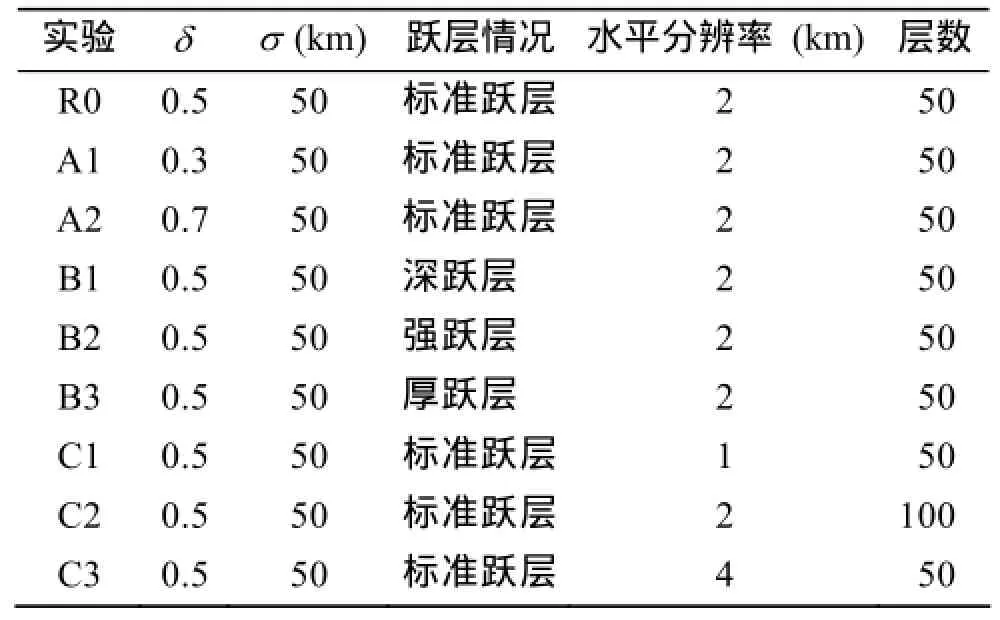
表 1 9个实验方案中地形参数、跃层状况、水平分辨率和垂向层数设置Tab. 1 Terrain parameters, thermocline structures, horizontal resolution, and vertical layers in nine cases
2 模拟结果及分析
图4为实验R0某一时刻瞬时流速u的空间分布,由图4可以看出清晰的射线结构从海脊发射出并向两侧传播, 同时在跃层和海底之间不停反射。这种射线结构实际上是海脊处产生的内潮在垂向多个模态叠加的结果。另一方面, 在上混合层中存在着与第一模态对应的强流, 并显示出很强的周期性。高模态内潮主要在海脊周围耗散掉, 低模态内潮可以远离海脊进行长距离传播。由于模型在东边界驱动, 海脊两侧的射线结构并不对称, 在海脊东侧正压潮能尚未损失, 因而内潮生成更加活跃。
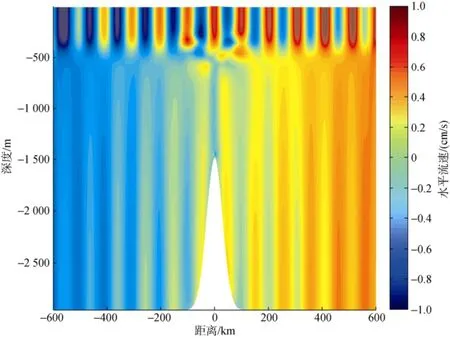
图4 实验R0中的瞬时水平流速Fig. 4 Internal tide beam in the R0 case (indicated by the instantaneous zonal velocity amplitude)

为了定量地分析在10 d的数值实验中发生了多少混合, 根据模拟结果计算了参数ΔN2来比较地形和层结条件变化导致的混合情况[21]。其中是初始状态的浮力频率,是潮周期平均的浮力频率。相比于实际观测中有限的观测站位和时间记录, 整个数值模拟区域的密度场是每小时输出一个, 能更加准确的刻画出由内潮引起的混合变化。从图6可以看出在海脊的的正上方和两侧跃层所在深度均发生了大量的混合(小于零的红色区域), 混合在距离海脊越近的地方越剧烈。这些混合的主要结果是通过上下水体进入该区域参与混合,加大了该区域上侧和下侧水体的密度梯度和(图6)。各个实验中内潮引起混合的强度与图4中内潮生成能量的多少基本一致。值得指出的是, 当跃层与海脊的距离更近时(B1), 内潮引起的混合最剧烈。因此, 地形和层结之间的空间关系对内潮的生成及其引起的混合有重要影响。
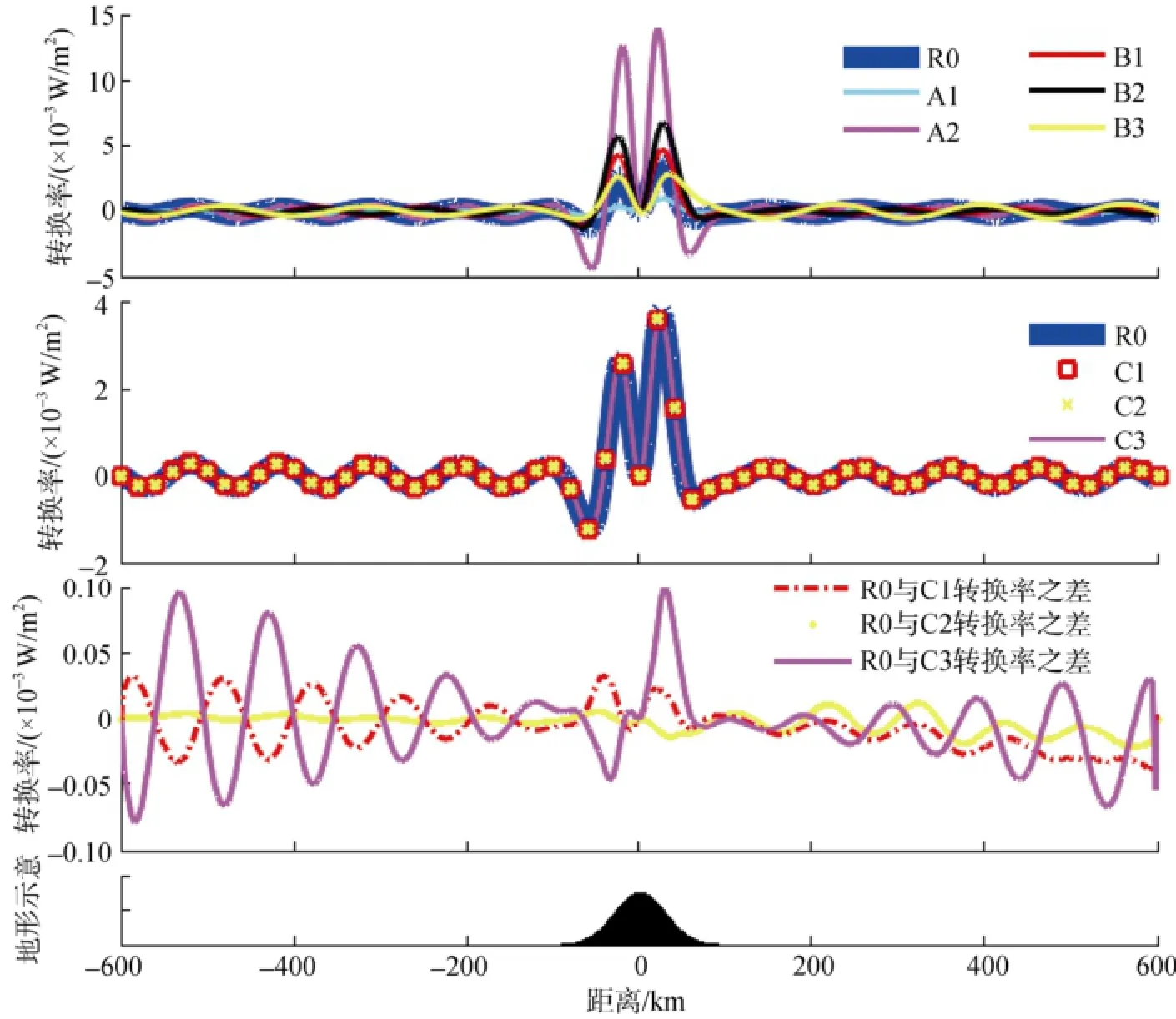
图5 实验R0, A1~A2, B1~B3和C1~C3中潮周期平均的垂向积分的正压潮向斜压潮转换率水平分布图Fig. 5 Horizontal distribution of the depth-integrated and period-averaged conversion rate in the R0, A1—A2, B1—B3, and C1—C3 cases
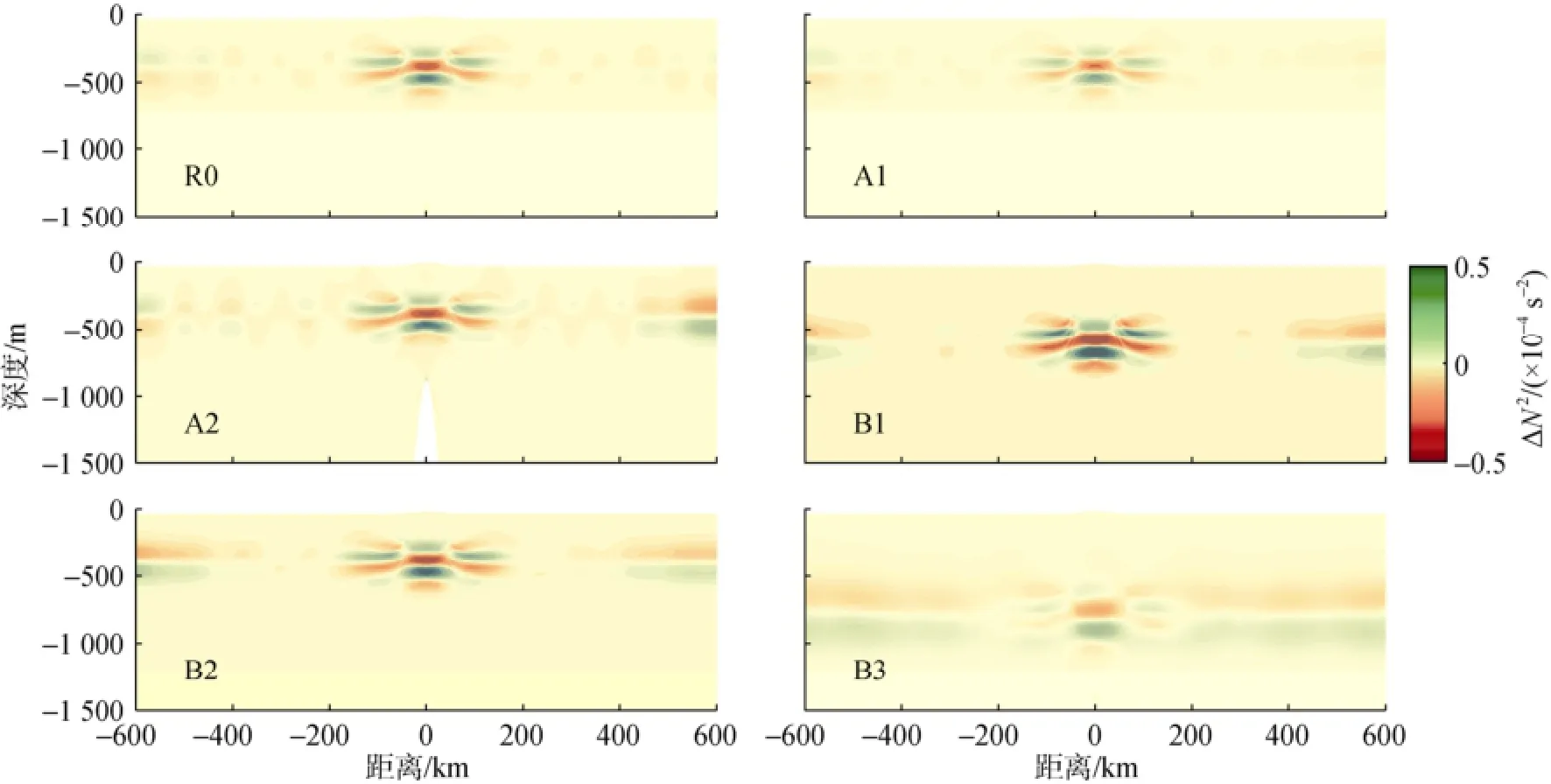
图6 实验R0, A1~A2, 和B1~B3中潮周期平均的浮力频率变化的空间分布图Fig. 6 Spatial distribution of period-averaged change in buoyancy frequencyin R0, A1—A2, and B1—B3 cases
3 结论
本文主要利用ROMS模式, 通过九组数值实验讨论了内潮产生对地形和背景层结环境的敏感性。模拟结果表明: (1)内潮主要产生于高斯海脊两侧地形梯度较大的超临界坡面处, 垂向多个模态叠加形成射线结构, 高模态内潮在海脊附近耗散, 低模态内潮可以远离海脊进行长距离传播。(2)地形和层结环境的变化对内潮的生成有重要影响, 不同条件下估算的正压潮向斜压潮转换率之间有数倍差异。如地形和层结条件不变, 不同的网格水平分辨率和垂向层数也会造成内潮转换率估算结果存在差异。因此合适的平滑方法和背景温盐场对内潮模拟尤为重要。(3)内潮的产生使得在海脊正上方和两侧海水(跃层所在深度)发生大量混合。地形和跃层之间的空间关系也会影响内潮的生成及其引起的混合强度。
因此, 高分辨率的地形和合适的背景层结是取得良好内潮模拟结果的关键。地形分辨率超过1/30°,对崎岖地形处进行局部加密, 或者采取特殊的平滑方法保证海脊高度不被削减[22]。选择内潮源区附近的长期观测资料或气候态资料作为背景层结场, 并在跃层所在深度附近进行加密。此外, 背景流、风应力、模型针对湍流不稳定的解决方案等其他因素对内潮产生影响如何?这有待于进一步研究。
[1] Egbert G D, Ray R D. Significant dissipation of tidal energy in the deep ocean inferred from satellite altimeter data[J]. Nature, 2000, 405: 775-778.
[2] Xu Zhenzhua, Yin Baoshu, Hou Yijun, et al. Variability of internal tides and near-inertial waves on the continental slope of the northwestern South China Sea [J]. Journal of Geophysical Research Oceans, 2013, 118: 1-15.
[3] 司广成, 于非, 刁新源. 南海北部中尺度涡与内波相遇的特征分析[J]. 海洋科学, 2014, 38(7): 89-94. Si Guangcheng, Yu Fei, Diao Xinyuan. Characteristics of encounter between a mesoscale eddy and internal waves in the northern South China Sea[J]. Marine Sciences, 2014, 38(7): 89-94.
[4] Zhao Zhongxiang. Internal tide radiation from the Luzon Strait[J]. Journal of Geophysical Research Oceans, 2014, 119: 5434-5448.
[5] Carter G S, Fringer M A, Becher J M, et al. Energetics of M2barotropic-to-baroclinic tidal conversion at the Hawaiian Islands[J]. Journal of Physical Oceanography, 2008, 38: 2205-2223.
[6] Jan S, Lien R C, Ting C H. Numerical study of baroclinic tides in Luzon Strait[J]. Journal of Oceanography, 2008, 64(5): 789-802.
[7] Kerry C G, Powell B S, Carter G S. Effects of remote generation sites on model estimates of M2internal tides in the Philippine Sea[J]. Journal of Physical Oceanography, 2013, 43(1): 187-204.
[8] Niwa Y, Hibiya T. Three-dimensional numerical simulation of M2internal tides in the East China Sea[J]. Journal of Geophysical Research, 2004, 109: C04027.
[9] Miao Chunbao, Chen Haibo, Lü Xianqing. An isopycnic-coordinate internal tide model and its application to the South China Sea[J]. Chinese Journal of Oceanology and Limnology, 2011, 29(6): 1339-1356.
[10] Gao Xiumin, Wei Zexun, Lü Xianqing, et al. Numerical study of tidal dynamics in the South China Sea with adjoint method[J]. Ocean Modelling, 2015, 92: 101-114.
[11] 蔡树群, 陈荣裕, 邱章. 底地形变化对内潮产生影响的数值研究[J]. 台湾海峡, 2000, 19(1): 74-81. Cai Shuqun, Chen Rongyu, Qiu Zhang. Numerical study about influence of bottom topographic change on generation of internal tide[J]. Journal of oceanography in Taiwan Strait, 2000, 19(1): 74-81.
[12] Gerkema T. Internal and interfacial tides: beam scattering and local generation of solitary waves[J]. Journal of Marine Research, 2001, 59(2): 227-255.
[13] Shchepetkin A F, McWilliams J C. The regional oceanic modeling system (ROMS): A split-explicit, free-surface, topography-following-coordinate oceanic model[J]. Ocean Modelling, 2005, 9: 347-404.
[14] Carter G S, Fringer O B, Zaron E D. Regional models of internal tides[J]. Oceanography, 2012, 25(2): 56-65.
[15] Vitousek S, Fringer O B. Physical vs. numerical dispersion in nonhydrostatic ocean modeling[J]. Ocean Modelling, 2011, 40(1): 72-86.
[16] Smagorinsky J. General circulation experiments with the primitive equations[J]. Monthly Weather Review, 1963, 91(3): 99-164.
[17] Mellor G L, Yamada T. Development of a turbulence closure model for geophysical fluid problems[J]. Reviews of Geophysics and Space Physics, 1982, 20: 851-875.
[18] Flather R A. A tidal model of the northwest European continental shelf[J]. Mem Soc Roy Sci, Liege, 1976, 6: 141-164.
[19] 江伟, 李培, 高文洋, 等. 西北太平洋密度跃层特征分析[J]. 海洋预报, 2010, 27(2): 15-21. Jiang Wei, Li Pei, Gao Wenxiang, et al. Pycnoclineanalysis on the Northwest Pacific Ocean[J]. Marine Forecasts, 2010, 27(2): 15-21.
[20] Niwa Y, Hibiya T. Estimation of baroclinic tide energy available for deep ocean mixing based on three-dimensional global numerical simulations[J]. Journal of Oceanography, 2011, 67: 493-502.
[21] Xing Jiuxing, Davies A M. On the interaction of internal tides over two adjacent sills in a fjord[J]. Journal of Geophysical Research, 2011, 116: 28-33.
[22] Sikiric M D, Janekovic I, and Kuzmic M. A new approach to bathymetry smoothing in sigma-coordinate ocean models[J]. Ocean Modelling, 2009, 29: 128-136.
Received: Mar. 16, 2016
Effects of topography and stratification change on the generation of internal tides
LIU Kun1,2,3, XU Zhen-hua1,2, YIN Bao-shu1,2
(1. Institute of Oceanology, the Chinese Academy of Sciences, Qingdao 266071, China; 2. Key Laboratory of Ocean Circulation and Wave, the Chinese Academy of Sciences, Qingdao 266071, China; 3. University of the Chinese Academy of Sciences, Beijing 100049, China)
internal tides; ROMS (Regional Ocean Modeling System); topography; stratification
Topography and stratification are the key factors in the generation of internal tides. In this study, we conducted nine well-designed ideal simulation experiments and used the Regional Ocean Modeling System (ROMS) to determine the sensitivity of internal tide generation to topography and stratification. The model results confirm that internal tides are mainly generated around the super-critical slope on both sides of the Gaussian ridge. Variations in topography and stratification greatly impact internal tide generation. When maintaining the same topographic and stratification conditions, the intensity of simulated internal tides changes with an increase in the horizontal resolution or number of vertical layers. The relative location of the topography and thermocline can also affect internal tide generation and the associated water mixing. High-resolution terrain and appropriate background stratification are the key factors for accurate simulation of internal tides. Our results may improve the simulation of internal tide generation.
P731
A
1000-3096(2016)11-0148-07
10.11759/hykx20160316002
(本文编辑: 刘珊珊 李晓燕)
2016-03-16;
2016-04-11
国家自然科学基金项目(41528601, 41376029, U1406401, 41421005); 中国科学院战略性先导科技专项(XDA10020104, XDA10020101);中国科学院青年创新促进会资助项目; 中国科学院创新交叉团队资助项目; 中国科学院前沿科学重点研究项目
[Foundation: National Natural Science Foundation of China, No.41528601, No.41376029, No.U1406401, No.41421005; Strategic Priority Research Program of the Chinese Academy of Sciences, No.XDA10020104, No.XDA10020101; Youth Innovation Promotion Association of the Chinese Academy of Sciences; Interdisciplinary Innovation Team of the Chinese Academy of Sciences; Key Research Program of Frontier Sciences, the Chinese Academy of Sciences]
刘昆(1988-), 男, 山东聊城人, 博士, 研究方向为内潮、内波数值模拟, 电话: 0532-82898932, E-mail: comealong@126.com; 徐振华, 通信作者, 研究员, 主要从事海洋环境数值模拟和内波动力学研究, 电话: 0532-82898931, E-mail: xuzhenhua@qdio.ac.cn
——李振声

